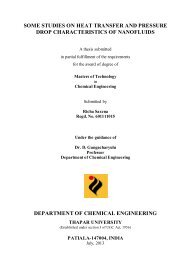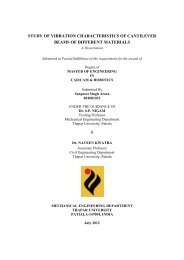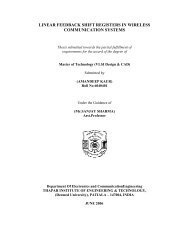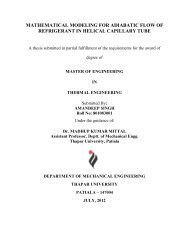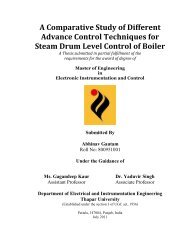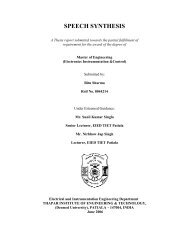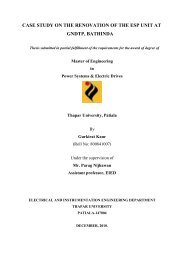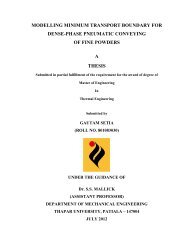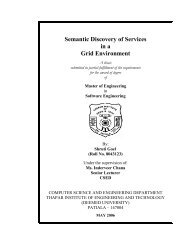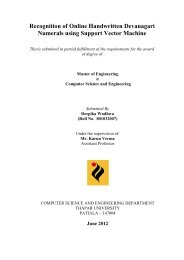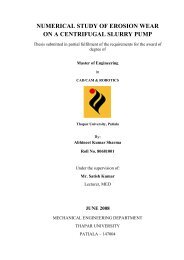from indigenous fermented foods and human gut ... - Thapar University
from indigenous fermented foods and human gut ... - Thapar University
from indigenous fermented foods and human gut ... - Thapar University
You also want an ePaper? Increase the reach of your titles
YUMPU automatically turns print PDFs into web optimized ePapers that Google loves.
3.7 Characterization of probiotic properties of Lactobacillus strains<br />
3.7.1 Low pH <strong>and</strong> bile salt tolerance<br />
58<br />
Chapter III Material <strong>and</strong> methods<br />
The isolated Lactobacillus strains were tested for their ability to resist at low pH <strong>and</strong><br />
bile salt. The pH value of gastric acid varies in the range of about 1.5-4.5 in a period of 2 h,<br />
depending on the entering time <strong>and</strong> the type of gastric contents. In the present study, pH 2<br />
was used as a representative gastric pH value. 24 h old culture of each Lactobacillus (10 8<br />
CFU/ml) was suspended in a MRS broth at pH 3 for 5 h at 37°C. The suspensions were then<br />
centrifuged at 3000 rpm for 10 min at 4°C twice <strong>and</strong> washed in sterile saline solution to<br />
remove the media. Cells were suspended in physiological solution <strong>and</strong> a series of 10-fold<br />
dilution (10 -2 -10 -10 ) was prepared. A given amount of each dilution (50 µl) was plated on to<br />
de Man Rogosa Sharpe (MRS) agar <strong>and</strong> incubated anaerobically at 37°C for 24 h. The<br />
percentage of the viable bacteria was calculated. Tolerance to bile salts was verified by<br />
inoculating 100 µl of bacterial suspension of each strain (10 8 CFU/ml) on to MRS agar<br />
containing bile salt at 0.3% concentration. Survival of the Lactobacillus strains was examined<br />
by counting the cells after 24 h of incubation at 37°C on to MRS agar.<br />
3.7.2 Resistance to 0.4% phenol<br />
Some aromatic amino acids derived <strong>from</strong> dietary or endogenously produced proteins<br />
can be deaminated in the <strong>gut</strong> by bacteria, leading to the formation of phenols (Suskovic et al.,<br />
1997). These compounds may exert a bacteriostatic effect against some Lactobacillus strains.<br />
Thus, testing for the resistance to phenol may generate further information on the potential<br />
for survival of Lactobacilli in gastrointestinal conditions (Xanthopoulos et al., 2000).<br />
Therefore, the ability of Lactobacillus strains to grow in the presence of phenol by<br />
inoculating cultures (1% of an overnight culture) in MRS broth with <strong>and</strong> without 0.4%<br />
phenol was tested. Serial dilutions were spread plated (100 μl aliquots) onto MRS agar at



